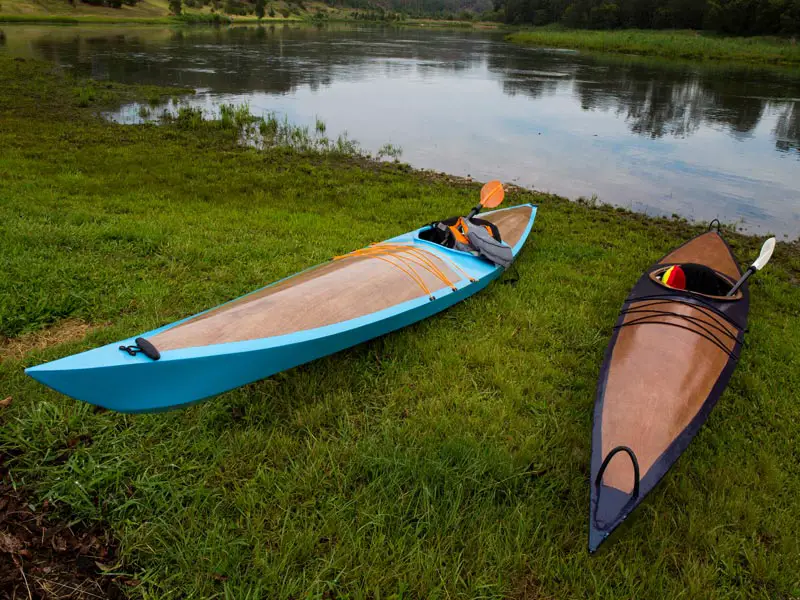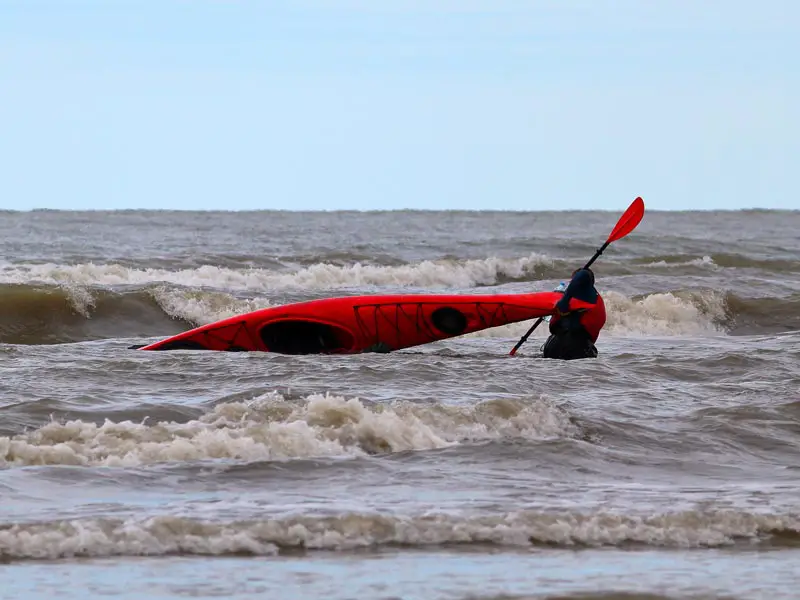Before I first started kayaking, I was excited but nervous. It all sounded fantastic, the sun, the water, the adventure; that magic mix of adrenaline and fun is always a recipe for happiness in my book. I was nervous because I lacked the skill and experience I had in other sports. Still, my main concern was that I would immediately end up in the water. I wondered: do kayaks flip easily?
Thus, I asked my kayaker friend, “do kayaks tip over easily?” He told me, in all seriousness, that in calm waters, a recreational kayak is tough to flip over. Furthermore, he said, there are plenty of strategies to avoid it. An ultra-light, professional-level kayak in white waters is a different story, but it will take a lot of practice to get to one of those.
Since now, having learned to kayak, this advice has held true. So, years later, I put together this post to help people who, like me, want to take on kayaking but are afraid of capsizing. So read on, learn, apply, and fall in love with this fantastic sport just like I did.
Start With The Basics of Kayaking
Let’s start this from the beginning. Like starting any new sport or practicing a new skill, you need to start slowly and build your skills and confidence as you go. In other words, you must learn how to crawl before you can run.
Try With Your Kayak On The Floor First
Yes, I know it sounds boring, but it is a must to learn some balance. First, try placing the kayak over an even surface and sit inside. Get your torso and your back straight. Then, pick up the paddles and mimic the movement you would do in the water.
This technique will teach you two valuable lessons:
- First, your own balance matters – Kayaking is all about balance. You’ll notice immediately that your movements move the vessel to the sides. To prevent this movement from getting you soaking wet, you need to practice how to paddle with a straight torso. This will keep the kayak balanced over the surface.
- It is steadier than you thought – The second valuable lesson is that kayaks are, indeed, more stable than they look. Go ahead, move around, and try to get it to fall on one side; you’ll realize it is more difficult than you expected. This shall give you more confidence once you hit the water.

Distribute The Weight Evenly In Your Kayak
A great way to add to the kayak’s natural balance is to distribute your gear inside of it evenly. For example, let’s say you want to take your trekking shoes, a waterproof backpack with some dry clothes, and some food for the adventure. That sounds like a great plan.
To prevent these extra items from unbalancing the kayak, you must organize them properly. This can mean placing a trekking boot on each side instead of both together, the backpack upfront, and the food behind you. This way, if all items weigh similarly, you would be helping balance instead of destroying it.
Before sitting inside the kayak, check that your weight distribution works. If it did, the boat should be sitting level (side to side and fore to aft); otherwise, you’ll have problems the entire trip.
Paddle Using Torso Rotation
Moving your shoulders each time you paddle doesn’t mean you are using your torso. Instead, it means you are relying only on your arms to propel you forward. The core of your body is where the strongest muscle groups are and doesn’t usually get tired as quickly as your arms.
Why is this important to keep your boat floating? Well, the more you master torso movements, the closer you’ll be to perfect balance. In other words, it is the torso and core that helps you paddle in a straight line avoiding any unbalancing movements that risk you tipping your kayak.
It takes a lot of time and practice to master your torso movements, but once you do, you’ll unlock the next level of paddling and experience all the fitness benefits that kayaking provides.
Choose The Right Conditions
Finally, let’s discuss the most effective way to reduce capsizing possibilities for your kayak: choosing the right conditions for your kayak adventures. This means:
- Start easy – Choose an easy endeavor as your first. Avoid white waters (rapids) and the open sea. Rather, keep it in calm, controlled waters like lagoons, lakes, and slow-moving rivers.
- Mind the weather – The wind can turn a beautiful and calm lagoon into a rollercoaster for which you might not be ready. Check the weather before you come out on your adventure, and when in doubt, stay on the shore.
Not only will this decrease the likelihood of you capsizing your kayak, but this will also avoid some of the dangers of kayaking.

Choose The Right Kayak For Your Ability
If you are starting out kayaking, you will want to avoid kayaks made for professionals seeking high speed and maneuverability. These are kayaks designed for experts, and the characteristics that make them fast or maneuverable will also make them less stable in the water.
Stick with a kayak that can offer you a good balance, weight, and size. Generally, this would be a recreational kayak.
What Happens If A Kayak Does Flip?
Although we agreed that the answer to the question “do kayaks tip over easily?” is a big no, it can happen. If that is the case, you must be prepared to handle the situation without panicking.
Indeed, most kayakers do it on purpose to familiarize themselves with the feeling and not lose calm if it happens unexpectedly in the middle of an adventure. So let’s go through some causes and techniques to stop it if you see it coming.
Potential causes
What can cause a kayak to flip over? Well, the cause is always one of these two:
- The paddler lost its balance – You could very well make a comparison between kayaking and riding a bike. In both, balance is crucial to keep going. If you lose your balance (paddle too strongly on one side, stretch too much for a selfie, etc.), your kayak will likely flip, so working on the above balance skills is a must.
- External forces – The second reason a kayak might flip over is when external forces act upon it, and you can’t stop them in time. For example, waves created by a speed boat when you’re paddling softly in a lagoon can make you lose balance. Either you control them with the following paddling advice or flip your kayak back up.
Some Paddling Advice
You need to know these main maneuvers to prevent your vessel from capsizing and what to do if you end up upside down in your kayak.
Practice The Low Brace
The low brace is a preventive move to stop your kayak from flipping over. It is a combined effort between your body and your blades. It is not a hard move but make sure you practice it so it will kick in instinctively when you see a capsize coming.
- Put your paddle across the cockpit, grab it strongly with both hands and make sure the blade is parallel to the water’s surface. Also, ensure that your knuckles are facing down and your elbows are facing up.
- Tilt the kayak towards the wave and hit the water with the back of your blade so it will go underneath the vessel.
- Perform a hip snap, pushing down with the hip on the opposite side of the wave and up with the hip on the wave side. This will level up the kayak and prevent it from capsizing.
Although it may seem complicated when you read it, it is a fairly simple, three-step movement that can save the day. Here’s Mike Aronoff with a demonstration video.
Practice The High Brace
The high brace is an even more powerful brace that will help you stay floating. It follows the same rules as the low brace, but instead of having knuckles down and elbows up, it requires elbows down and knuckles up.
Let’s check the step-by-step instructions:
- Keep a straight back and roll your paddle up until your forearms are close to vertical and the paddle sits horizontally under your chin.
- Slap the water with the paddle, bring it towards you, and drop your head towards the water.
- As you are doing the head-drop movement, do another hip snap. By pulling up the lowest knee, you shall get the push you need to level the vessel.
Again, it seems like a hard task, but it is easy to pull off. Here’s a video of a professional kayaker showing you how.
Learn To Wet Exit
So, the worst has happened, and you are capsizing. Maybe you haven’t reacted fast enough to perform a brace, or maybe your technique needs some work. Of course, not all hope is lost, but if you don’t know how to roll your kayak upright, you will need to get out underwater. This maneuver is called a wet exit.
- Stay calm – The worst thing you can do now is panic and thrash around underwater.
- Lean forward – Lean as far forward as you possibly can, like you are kissing the deck of your kayak.
- Grab the pull loop of your spray skirt and pull to release yourself.
- Push yourself out – With your hands on the cockpit side, push yourself forward and keep your legs together to prevent them from getting stuck on the way out.
- Float to the surface with your PFD.
Finally, a word of advice is that these movements may seem counter-intuitive, but they are utterly effective. Practice them, so you are ready to use them when the time comes.
Can Kayaks Sink?
So, now we know if kayaks can flip and how to try to stop it from happening. Another common concern is whether kayaks can sink.
To answer the question of whether a kayak can sink, it depends on the kind of kayak you are paddling on. There are two major kinds of kayaks: sit-on-kayaks and sit-inside kayaks.
The sit-on-kayaks are unsinkable because they are sealed plastic vessels with scupper holes that can handle the water coming in over them. On the other hand, sit-inside kayaks have open hulls. Therefore, water entering the cockpit could potentially sink the vessel.
However, most good quality sit-inside kayaks have sealed bulkheads that trap air inside the kayak and will stop them from sinking entirely if they get swamped. Bulkheads also give you watertight compartments that you can use for carrying cargo. However, if your kayak doesn’t have bulkheads, you can use float bags to prevent it from sinking.
The Conclusion – Do Kayaks Tip Over Easily?
Hopefully, this article sheds new light on the topic and has eased your fears. Fortunately, kayaks don’t tip over easily, and you have to get into some tough waters to make them capsize.
That being said, there are plenty of maneuvers to perform that will help you prevent it if you see it coming. And, finally, if it happens, you’ll realize that it isn’t such a big deal, and you can keep on paddling the entire afternoon.
Don’t let fear of capsizing stop you from such a wonderful sport as kayaking. The most amazing experiences wait for you when you are out on the water, don’t miss out!
Happy paddling!
